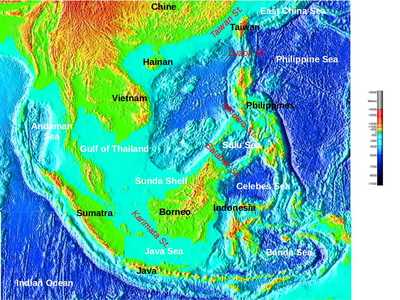Research objectives: water and matter in the river-estuary-ocean continuum in delta regions

Topography of the South East Asia region, from GEBCO
LOTUS general scientific objective is to understand and monitor the functioning and variability of the transport and fate of water and associated matter in the atmosphere-continent-ocean coupled system in coastal regions of Viet Nam and South East Asia.
Deltas are key regions of this system: they are at the interface between the continent and the ocean and submitted to a large range of natural and anthropogenic influences. Identifying and understanding the processes that control water and matter fluxes in those regions and their interactions with the oceanic and continental areas is therefore of primary importance.
Our goal is therefore to focus on the continuum region that goes from the river estuary to the open ocean, by addressing three main questions:
- Which physical and biogeochemical processes control the transport and fate of water and matter through the river - estuary – coastal area – open ocean region? How do they interact?
- Which natural and anthropogenic factors are involved in the different scales of variability of this transport and fate?
- How can those processes and scales of variability be observed through in-situ and remote sensing observations and be represented through modeling?


Mekong and Red River deltas
High-resolution coupled physical-biogeochemical-sediment modeling, multi-sensors satellite observations and in-situ measurements are used complementarily to answer to these questions. Our main study areas go from the watershed and delta regions (Red River and Mekong) to the whole South China Sea.